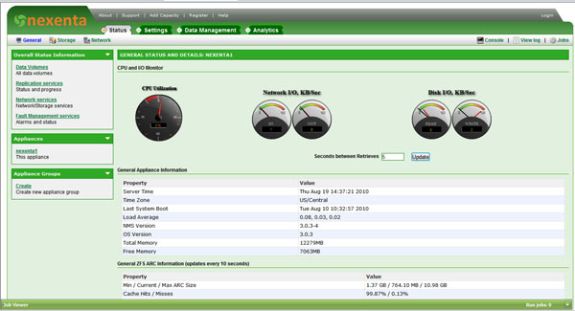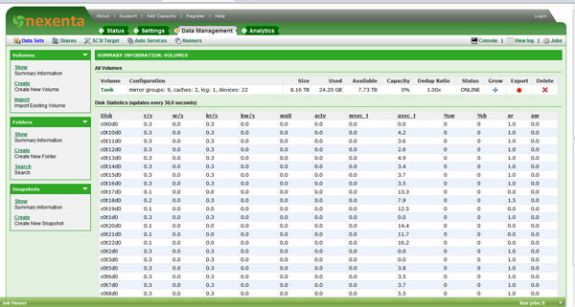ZFS - Building, Testing, and Benchmarking
by Matt Breitbach on October 5, 2010 4:33 PM EST- Posted in
- IT Computing
- Linux
- NAS
- Nexenta
- ZFS
Nexenta
Nexenta is to OpenSolaris what OpenFiler is to Linux or FreeNAS is to FreeBSD. It is a purpose built version of OpenSolaris designed primarily around storage networking including NFS, CIFS, and iSCSI/FC block based storage. Nexenta has taken a lot of time building a great front-end to manage ZFS enabled storage and integrate a plug-in manager that can extend the abilities of a standard x86 platform to rival the best
Nexenta comes in three flavors, Nexenta Core, Nexenta Community, and Nexenta Enterprise. The availability of these three versions allows you to select what kind of product you want, and what kind of expenditures that you will incur.
Nexenta Core is the most basic of the options, but it is also the most forgiving in terms of licensing. Nexenta Core is a command line interface platform only. It is based on an OpenSolaris kernel, and an Ubuntu Userland. There is no limit to the amount of storage that you can configure or use with Nexenta Core, and it is completely free. Nexenta Core can be found here.
Nexenta Community is the next step up. Nexenta Community is based on Nexenta Core, and includes a great GUI interface for managing all aspects of the storage platform. Nexenta Community is also free, but it is limited to 12TB of used storage. Nexenta Community Edition can be found here.
Nexenta Enterprise is the top-level offering. Nexenta Enterprise is a superset of Nexenta Community with many Enterprise level features, including support options. Nexenta Enterprise is licensed based on RAW storage capacity. You can find pricing information here.
Screenshots of web GUI
Nexenta has been very easy to use in our testing. After a few minutes of familiarization with the interface everything is pretty straight forward. You can go from a bare installation to something that has an array configured, an iSCSI target configured, and is ready to take data in a matter of 5-10 minutes. All of the features for sending out notifications and for lighting up indicator lights work as expected and are easy to configure. With just a few menu clicks you're ready to enter all of the information that the system needs to notify you about any problems that it encounters.
Some of the shortcomings that we saw in the Nexenta Enterprise offering were in the reporting and support areas of the product. We did not investigate the reporting problem in depth, as it was not pertinent to the performance data of the system. We would expect that with a little troubleshooting it would be something that would be easily resolved. Throughout the testing process though the daily reports stated that there was no network traffic being generated even though we were loading the interface quite heavily during testing.
This brings us to our next issue that we had with Nexenta, and that was the support channels. We would have gladly troubleshot the issues with reporting if we thought it was going to be done in a timely manner. Since we were using the Enterprise Trial license the support was lackluster at best. We were assured by sales representatives that paid-for support is much faster and much better than the "free trial" support. Free Trial support is treated as their lowest priority support queue. We were not impressed with this as we have always thought of a time-limited free trial period to be pre-sales. If you want to convert someone from a non-paying free trial to a paid product, show them how good the product and support is during that period.












102 Comments
View All Comments
MGSsancho - Tuesday, October 5, 2010 - link
I haven't tried this myself yet but how about using 8kb blocks and using jumbo frames on your network? possibly lower through padding to fill the 9mb packet in exchange for lower latency? I have no idea as this is just a theory. dudes in the #opensolaris irc chan have always recommended 128K or 64K depending on the data.solori - Wednesday, October 20, 2010 - link
One easy way to check this would be to export the pool from OpenSolaris and directly import it to NexentaStor and re-test. I think you'll find that the differences - as your benchmarks describe - are more linked to write caching at the disk level than partition alignment.NexentaStor is focused on data integrity, and tunes for that very conservatively. Since SATA disks are used in your system, NexentaStor will typically disable disk write cache (write hit) and OpenSolaris may typically disable device cache flush operations (write benefit). These two feature differences can provide the benchmark differences you're seeing.
Also, some "workstation" tuning includes the disabling of ZIL (performance benefit). This is possible - but not recommended - in NexentaStor but has the side effect of risking application data integrity. Disabling the ZIL (in the absence of SLOG) will result in synchronous writes being committed only with transaction group commits - similar performance to having a very fast SLOG (lots of ARC space helpful too).
fmatthew5876 - Tuesday, October 5, 2010 - link
I'd be very interested to see how FreeBSD ZFS benchmark results would compare to Nexenta and Open Solaris.mbreitba - Tuesday, October 5, 2010 - link
We have benchmarked FreeNAS's implimentation of ZFS on the same hardware, and the performance was abysmal. We've considered looking into the latest releases of FreeBSD but have not completed any of that testing yet.jms703 - Tuesday, October 5, 2010 - link
Have you benchmarked FreeBSD 8.1? There were a huge number of performance fixes in 8.1.Also, when was this article written? OpenSolaris was killed by Sun on August 13th, 2010.
mbreitba - Tuesday, October 5, 2010 - link
There was a lot of work on this article just prior to the official announcement. The development of the Illumos foundation and subsequent OpenIndiana has been so rapidly paced that we wanted to get this article out the door before diving in to OpenIndiana and any other OpenSolaris derivatives. We will probably add more content talking about the demise of OpenSolaris and the Open Source alternatives that have started popping up at a later date.MGSsancho - Tuesday, October 5, 2010 - link
Not to mention that projects like illumos are currently not recommended for production, Currently only meant as a base for other distros (OpenIndiana.) Then there is Solaris 11 due soon. I'll try out the express version when its released.cdillon - Tuesday, October 5, 2010 - link
FreeNAS 0.7.x is still using FreeBSD 7.x, and the ZFS code is a bit dated. FreeBSD 8.x has newer ZFS code (v15). Hopefully very soon FreeBSD 9.x will have the latest ZFS code (v24).piroroadkill - Tuesday, October 5, 2010 - link
This is relevant to my interests, and I've been toying with the idea of setting up a ZFS based server for a while.It's nice to see the features it can use when you have the hardware for it.
cgaspar - Tuesday, October 5, 2010 - link
You say that all writes go to a log in ZFS. That's just not true. Only synchronous writes below a certain size go into the log (either built into the pool, or a dedicated log device). All writes are held in memory in a transaction group, and that transaction group is written to the main pool at least every 10 seconds by default (in OpenSolaris - it used to be 30 seconds, and still is in Solaris 10 U9). That's tunable, and commits will happen more frequently if required, based on available ARC and data churn rate. Note that _all_ writes go into the transaction group - the log is only ever used if the box crashes after a synchronous write and before the txg commits.Now for the caution - you have chosen SSDs for your SLOG that don't have a backup power source for their on board caches. If you suffer power loss, you may lose data. Several SLC SSDs have recently been released that have a supercapacitor or other power source sufficient to write cache data to flash on power loss, but the current Intel like up doesn't have it. I believe the next generation Intel SSDs will.